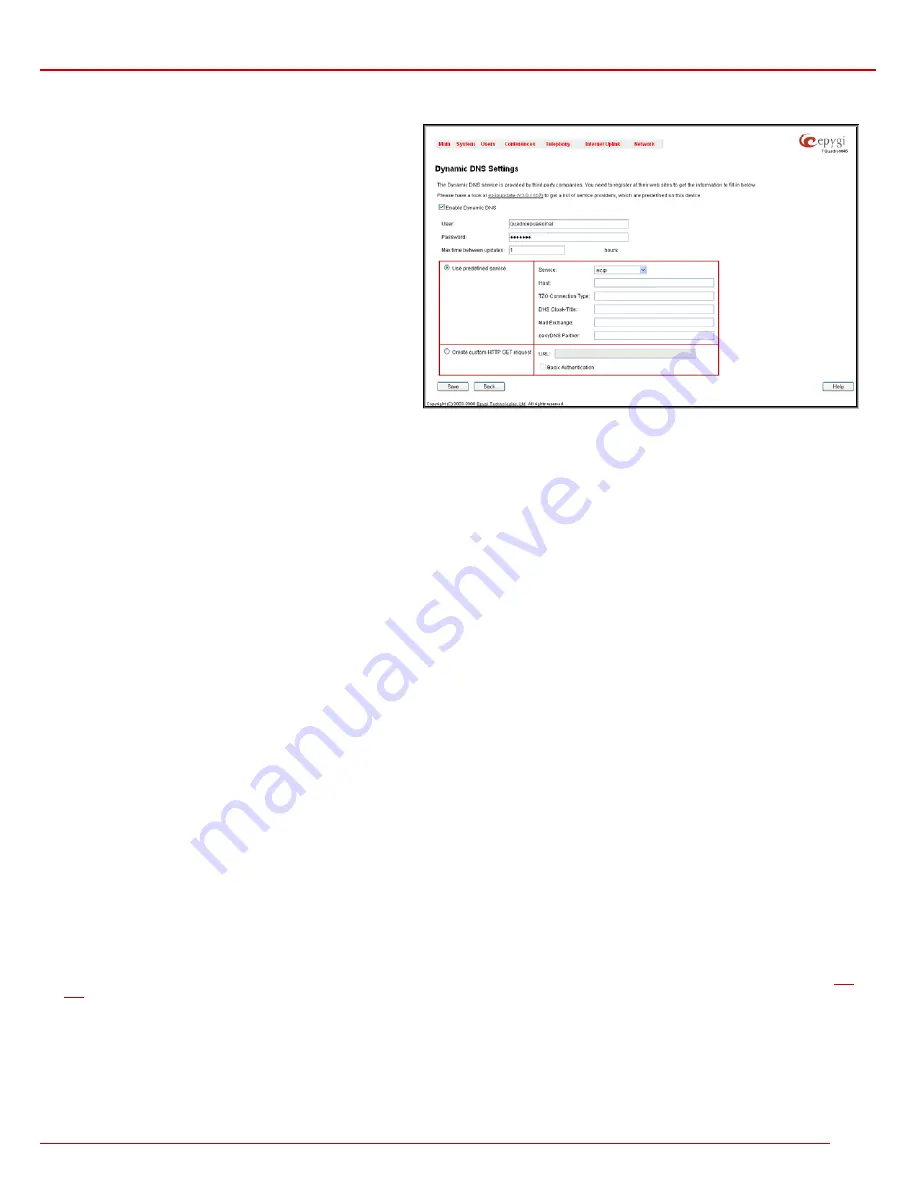
QuadroM 32x/8L/26x/12Li/26xi Manual II: Administrator's Guide
Administrator’s Menus
QuadroM 32x/8L/26x/12Li/26xi; (SW Version 5.2.x)
140
The
Dynamic DNS Settings
page provides the following
components:
The
Enable Dynamic DNS
checkbox selection enables the
dynamic DNS service.
The
User
text field requires the username specified during the
registration at the DynDNS provider.
The
Password
text field requires the password specified during
the registration at the DynDNS provider.
The
Max time between updates
text field requires entering the
period between two updates (in hours). The values entered in
these fields should be greater than 24, otherwise the error
message “Update interval times smaller than 24 hours are too
small” will appear. Normally, whenever you set up a connection
to the Internet, the DynDNS is updated at least once in the
period indicated in this field.
The
Use predefined service
radio button leads to the manual
configuration of the DynDNS service. The selection enables the
following optional settings:
The
Service
drop down list contains the provider list where the
administrator needs to select the one that it has been
subscribed to.
Fig. II-247: Dynamic DNS Settings page
The
Host
text field requires the name of the host on the Internet.
The
TZO Connection Type
text field is used for
a special parameter required by the DynDNS provider TZO.
The
DHS Cloak-Title
text field is used for
a special parameter required by the DynDNS provider DHS.
The
Mail Exchange
text field
requires the address of the e-mail server where the DynDNS service provider will relay your e-mails.
Attention:
If this service is used, ensure that there is port forwarding configured for SMTP (port 25) to the internal e-mail server.
The
easyDNS Partner
text field is used for
a special parameter required by the DynDNS provider easyDNS.
Selecting the
Create Custom HTTP GET Request
radio button will switch to the custom settings of the DynDNS service. Normally, the DynDNS
provider uses HTTP get requests to map dynamic IP addresses to host names. If the HTTP receive request is known to you, choose the
Create
Custom HTTP GET Request
radio button and enter the appropriate value into the
URL
text field.
The selection enables the following optional settings:
The
URL
text field requires the complete request to be sent to the DynDNS server. Normally it has the following format:
http://www.server.domain:port/scriptpath/scriptname?param1=value1¶m2=value2
The request modifies the nameserver database so that the hostname will be resolved to the new IP address.
The
Basic Authentication
checkbox enables the encoding of the username and password entered in the text fields above, and then uses the
Basic
Authentication
method to notify the provider about the user authentication settings.
Most of the DynDNS providers require an authentication for security. Authentication parameters can be provided in the
URL
text field to be used for
the HTTP get request. The
Basic Authentication
checkbox can be selected if no authentication parameters to be provided.
Firewall and NAT
The
Firewall Configuration
page allows setting up a firewall, configuring the security level and enabling the NAT and IDS services of Quadro.
A
Firewall
is a security service configured by the Quadro administrator based on various criteria. The firewall allows or blocks traffic based on
policies, services and/or IP addresses. The firewall has several levels of security policies (low, medium or high). The administrator may add
additional service-based rules. Filtering rules will take effect only if the Firewall has been enabled and are independent from the selected firewall
security level.
NAT
(Network Address Translation) is used to allow Quadro LAN members to connect to the Internet using Quadro's WAN IP address. The
Quadro/NAT also handles forwarding incoming packets from the WAN to the PCs or devices on Quadro’s LAN.
The
IDS
(Intrusion Detection System) is a type of firewall, but together with deleting dangerous packets or packets containing intrusion attacks, IDS
generates a log file with information about these dropped packets and the senders responsible for those packets. The log can be viewed on the
IDS
Log
page and notifications about them can be sent to the user in various ways such as e-mail, flashing LED and display notification.
The
Firewall Configuration
page offers the following components:
The
Enable IDS
checkbox selection enables the Intrusion Detection System. The
Enable NAT
checkbox selection enables Network Address
Translation.






























